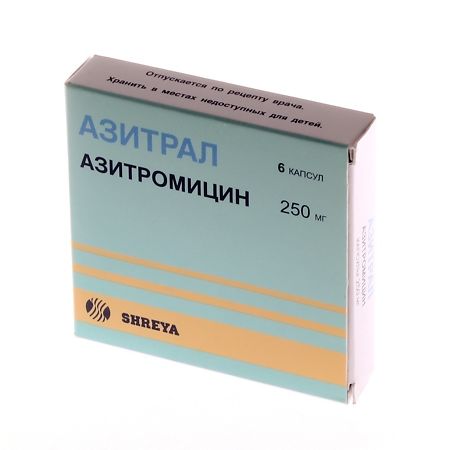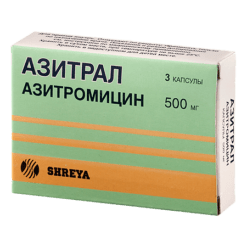No products in the cart.
Azitral, capsules 250 mg, 6 pcs.
€1.00
Out of stock
(E-mail when Stock is available)
Description
Azitral is a broad spectrum antibiotic. It is a representative of the subgroup of macrolide antibiotics – azalides.
Azitral has a bactericidal effect when creating high concentrations in the focus of inflammation.
Azithromycin is sensitive to Gram-positive cocci: Streptococcus pneumoniae, St. pyogenes, St. agalactiae, group CF and G streptococci, Staphylococcus aureus, St. viridans; Gram-negative bacteria: Haemophilus influenzae, Moraxella catarrhalis, Bordetella pertussis, B.parapertussis, Legionella pneumophila, H.ducrei, Campylobacter jejuni, Helicobacter Pylori, Neisseria gonorrhoeae and Gardnerella vaginalis; some anaerobic microorganisms: Bacteroides bivius, Clostridium perfringens, Peptostreptococcus spp; and Chlamydia trachomatis, Mycoplasma pneumoniae, Ureaplasma urealyticum, Treponema pallidum, Borrelia burgdoferi. Azithromycin is inactive against Gram-positive bacteria resistant to erythromycin.
Indications
Indications
Infectious and inflammatory diseases caused by microorganisms sensitive to the drug:
Active ingredient
Active ingredient
Composition
Composition
1 capsule contains azithromycin 250 mg;
excipients:
anhydrous lactose,
corn starch,
magnesium stearate,
sodium lauryl sulfate
How to take, the dosage
How to take, the dosage
Overly, 1 hour before or 2 hours after the meal once a day.
In adults with infections of the upper and lower respiratory tracts – 0.5 g/day at 1 course over 3 days (course dose – 1.5 g).
Infections of skin and soft tissue – 1 g/day on the first day at 1 course, further on 0.5 g/day every day from 2nd to 5th day (cumulative dose – 3 g).
In case of acute infections of the urogenital organs (uncomplicated urethritis or cervicitis) – 1 g once.
In case of Lyme disease (borreliosis) for the treatment of stage I (erythema migrans) – 1 g on the first day and 0.5 g daily since the 2nd to 5th day (course dose – 3 g). In gastric and duodenal ulcer associated with Helicobacter pylori – 1 g/day for 3 days as a part of combined anti-Helicobacter therapy.
In children the dose is 10 mg/kg 1 time per day for 3 days or 10 mg/kg on the first day and then 5-10 mg/kg/day for 4 days for 3 days (the course dose is 30 mg/kg).
In the treatment of erythema migrans in children, the dose is 20 mg/kg on the first day and 10 mg/kg on days 2 to 5. By IV, in treatment of pneumonia – 0.5 g once for at least 2 days, subsequently – orally, 2 capsules (0.25 g each); course – 7-10 days.
In pelvic infections – intravenous, 0.5 g once and then – orally, 2 capsules (0.25 g each); course – 7 days.
Interaction
Interaction
Antacids (aluminum and magnesium-containing), ethanol and food delay and decrease absorption.
When co-administration of warfarin and azithromycin (in usual doses) no change in prothrombin time was found, however, given that in the interaction of macrolides and warfarin may increase the anticoagulation effect, patients need careful monitoring of prothrombin time.
Digoxin: increase in digoxin concentration.
Ergotamine and dihydroergotamine: increased toxic effects (vasospasm, dysesthesia).
Triazolam: decreased clearance and increased pharmacological action of triazolan.
. Slows excretion and increases plasma concentrations and toxicity of cycloserine, indirect anticoagulants, methylprednisolone, felodipine, and drugs that undergo microsomal oxidation (carbamazepine, Terfenadine, cyclosporine, hexobarbital, ergot alkaloids, valproic acid, disopyramide, bromocriptine, phenytoin, oral hypoglycemic agents, theophylline, etc. xanthine derivatives) – due to inhibition of microsomal oxidation in hepatocytes by azithromycin).
Linkosamines weaken efficacy, tetracycline and chloramphenicol increase it. Pharmaceutically incompatible with heparin.
Special Instructions
Special Instructions
A break of 2 hours should be observed when concomitant use of antacids.
Hypersensitivity reactions may persist in some patients after treatment withdrawal, which requires specific therapy under medical supervision.
Contraindications
Contraindications
Hypersensitivity (including to other macrolides), hepatic and/or renal failure, lactation.
. With caution – pregnancy (can be used in cases when the benefit from its use significantly exceeds the risk which always exists when using any drug during pregnancy), arrhythmia (ventricular arrhythmias and prolongation of QT interval are possible), children under 16 years old (intravenous, tablets, capsules), children with significant liver or renal function disorders, infants (oral suspension).
Side effects
Side effects
Digestive system: when administered orally – diarrhea (5%), nausea (3%), abdominal pain (3%); 1% or less – dyspepsia, flatulence, vomiting, melena, cholestatic jaundice, increased “liver” transaminases activity; also in children – constipation, anorexia, gastritis; oral mucosa candidiasis (when IV administration).
Systemic diseases: palpitations, chest pain (1% or less).
Nervous system: dizziness, headache, vertigo, somnolence; in children – headache (in otitis media therapy), hyperkinesia, anxiety, neurosis, sleep disturbance (1% or less).
Urogenital system : vaginal candidiasis, nephritis (1% or less).
Allergic reactions: rash, photosensitization, Quincke’s edema; in intravenous administration – bronchospasm (1% or less).
Others: increased fatigue; in children – conjunctivitis, pruritus, urticaria; when administered intravenously – change in taste (1% or less).
Overdose
Overdose
Symptoms: severe nausea, temporary hearing loss, vomiting, diarrhea.
Similarities
Similarities
Additional information
| Shelf life | 2 years |
|---|---|
| Conditions of storage | In a dry place, at a temperature not exceeding 25 °C |
| Manufacturer | Shreya Life Sciences Pvt. Ltd, India |
| Medication form | capsules |
| Brand | Shreya Life Sciences Pvt. Ltd |
Other forms…
Related products
Buy Azitral, capsules 250 mg, 6 pcs. with delivery to USA, UK, Europe and over 120 other countries.















